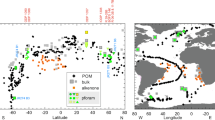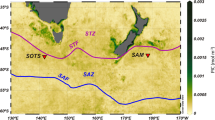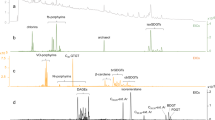Abstract
Marine sediments contain a great diversity of organic molecules which have originated in situ and from planktonic organisms. The establishment of a direct relationship between possible ‘chemical markers’ and source organisms would enable studies of biomass-turnover time to be undertaken, using dated sediment cores as temporal records. Studies of the influence of long-term environmental variations on the abundance of planktonic flora and fauna are potentially amenable to this approach. Chemical compounds biosynthesized by organisms in the water column are, however, subjected to microbial attack, oxidation and other degradative processes before, and indeed after, sedimentary incorporation1. We show here that changes in the sedimentary abundances and distribution of selected chemical moieties produced by oxidative degradation of fatty acids of planktonic origin, can provide evidence for a change in algal abundance and distribution in the overlying oceanic waters.
This is a preview of subscription content, access via your institution
Access options
Subscribe to this journal
Receive 51 print issues and online access
$199.00 per year
only $3.90 per issue
Buy this article
- Purchase on Springer Link
- Instant access to full article PDF
Prices may be subject to local taxes which are calculated during checkout
Similar content being viewed by others
References
Didyk, B. M., Simoneit, B. R. T., Brassell, S. C. & Eglinton, G. Nature 272, 216–222 (1978).
Gillan, F. T., Johns, R. B. & Volkman, J. K. Geochim. cosmochim. Acta (submitted).
Ryhage, R. & Stenhagen, E. Arkiv. Kemi 14, 483–496 (1959).
Beynon, J. K., Saunders, R. A. & Williams, A. E. The Mass Spectra of Organic Molecules (Elsevier, Amsterdam, 1968).
Philp, R. P. Nature 262, 134–136 (1976).
Gillan, F. T. et al. in Advances in Organic Geochemistry 1981 (in the press).
Doelle, H. W. Bacterial Metabolism 2nd edn (Academic, New York, 1975).
Kolattukudy, P. E., Croteau, R. & Buckner, J. S. in Chemistry and Biochemistry of Natural Waxes (ed. Kolattukudy, P. E.) 289–347 (Elsevier, Amsterdam, 1976).
Chuecas, L. & Riley, J. P. J. mar. biol. Ass. U.K. 49, 97–116 (1969).
Volkman, J. K., Smith, D. J., Eglinton, G., Forsberg, T. E. V. & Corner, E. D. S. J. mar. biol. Ass. U.K. 61, 509–527 (1981).
Johns, R. B., Nichols, P. D. & Perry, G. J. Phytochemistry 18, 799–802 (1979).
Bostrom, K., Kraemer, T. & Gartner, S. Chem. Geol. 11, 123–148 (1973).
Volkman, J. K., Gillan, F. T., Johns, R. B. & Eglinton, G. Geochim. cosmochim. Acta 45, 1817–1828 (1981).
Author information
Authors and Affiliations
Rights and permissions
About this article
Cite this article
Gillan, F., Johns, R. Oxic diagenetic products as indicators of past oceanic algal populations and diversity. Nature 298, 744–746 (1982). https://doi.org/10.1038/298744a0
Received:
Accepted:
Issue Date:
DOI: https://doi.org/10.1038/298744a0
Comments
By submitting a comment you agree to abide by our Terms and Community Guidelines. If you find something abusive or that does not comply with our terms or guidelines please flag it as inappropriate.



